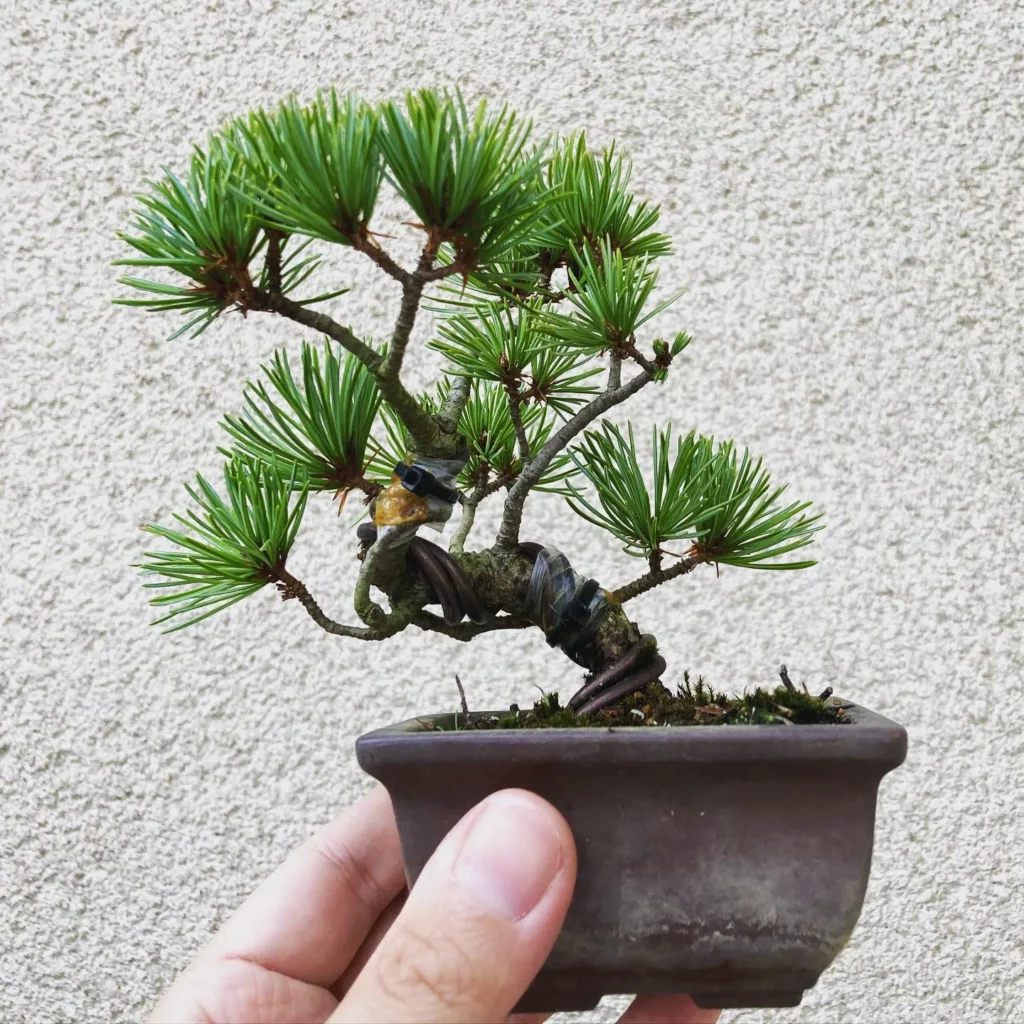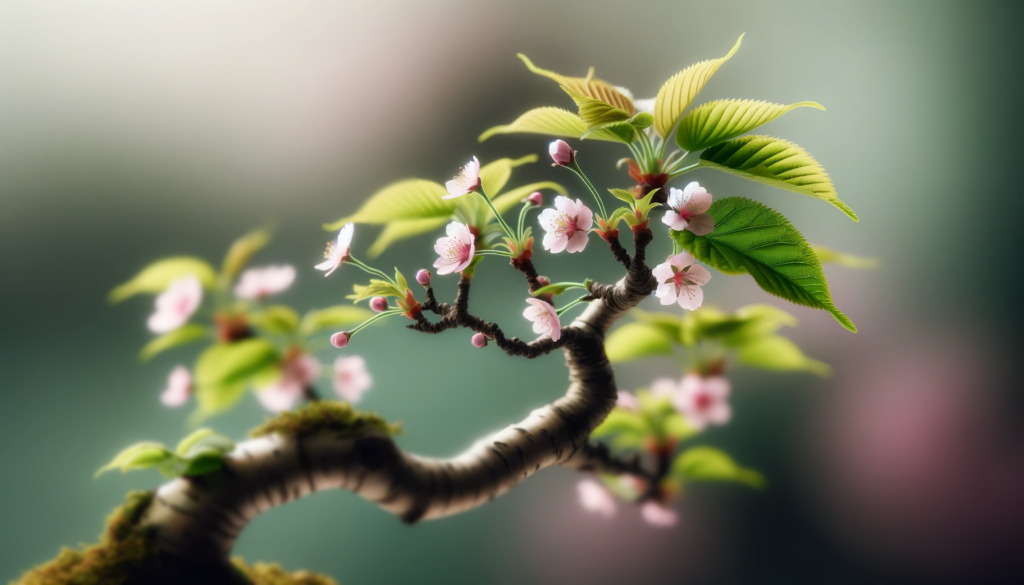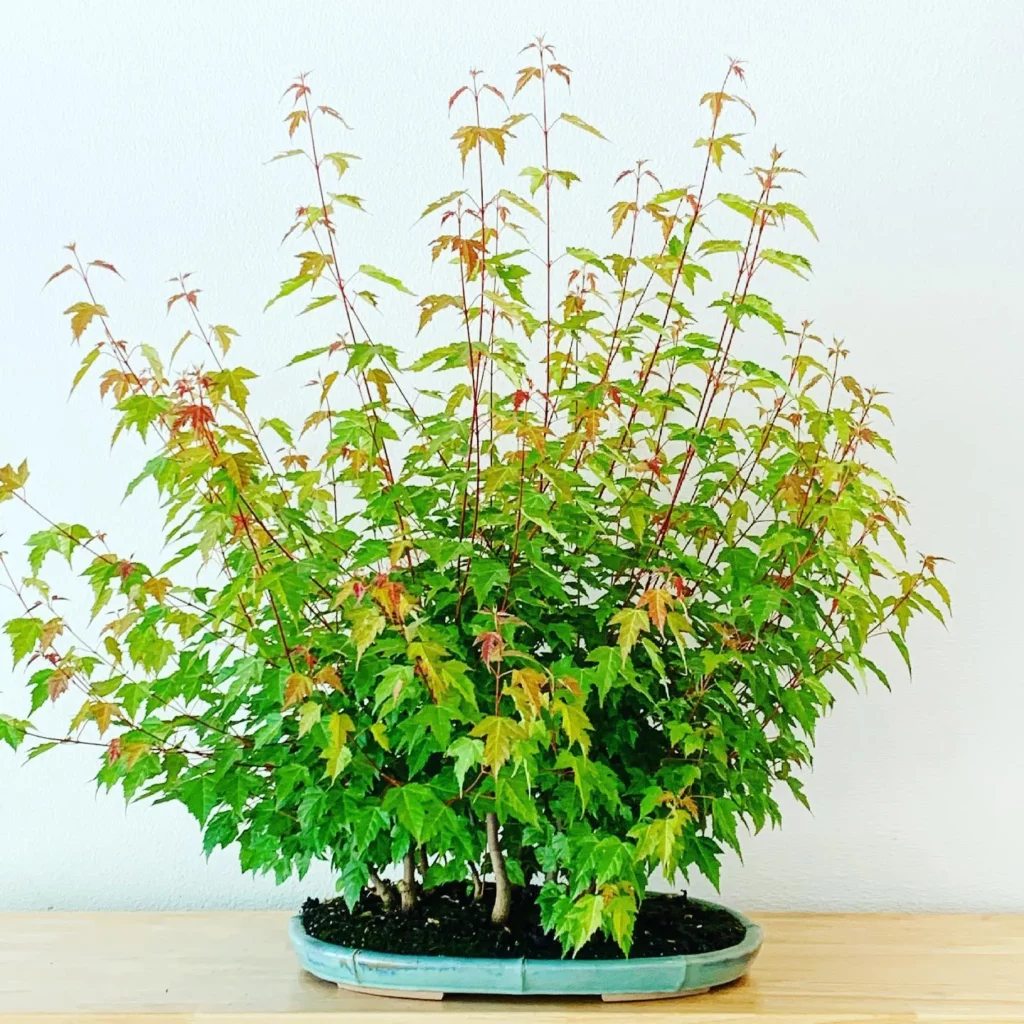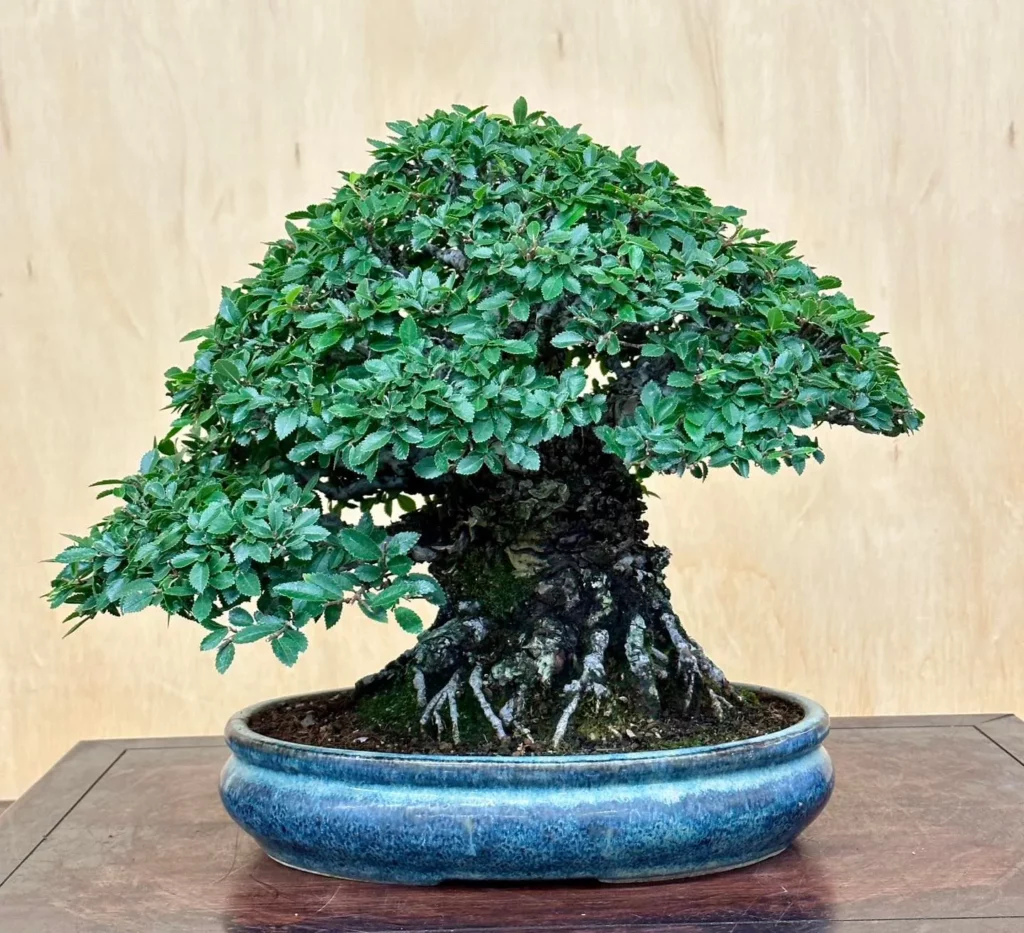Yaupon Holly Bonsai, also known as Ilex vomitoria, is a captivating plant with distinct features that make it a standout in any bonsai collection. This native American plant usually grows as a shrub but can occasionally be cultivated as a tree. Its dark green, oval to egg-shaped leaves add a touch of elegance to the bonsai design.
Key Takeaways:
- Yaupon Holly Bonsai, scientifically known as Ilex vomitoria, is a versatile and fast-growing plant ideal for bonsai cultivation.
- It has small leaves, develops ramification quickly, and can grow up to 45 feet in height.
- Yaupon Holly Bonsai can thrive in various lighting conditions, from full shade to full sun.
- Regular watering to maintain evenly moist soil is crucial for the plant’s health.
- Fertilizing with a balanced liquid fertilizer every two to three weeks will promote healthy growth.
Appearance of Yaupon Holly Bonsai



One of the captivating aspects of Yaupon Holly Bonsai is the appearance of small red berries that adorn the plant in the fall. These berries, found exclusively on female varieties, add a delightful pop of color and enhance the overall aesthetic appeal. Additionally, the plant can reach a height of up to 45 feet when grown in its natural form. However, for bonsai enthusiasts, there are dwarf cultivars available that stay smaller, typically around five feet, making them more manageable for bonsai cultivation.
The combination of dark green leaves, vibrant red berries, and the potential for varying heights makes Yaupon Holly Bonsai a stunning addition to any bonsai collection.
Light Requirements for Yaupon Holly Bonsai



Proper lighting is essential for the healthy growth and development of your Yaupon Holly Bonsai. This versatile plant can tolerate a wide range of lighting conditions, from full shade to full sun. However, it is important to note that the amount of light your bonsai receives will affect its foliage density and overall appearance.
Indoor Lighting:
If you are growing your Yaupon Holly Bonsai indoors, place it near a south-facing window where it can receive bright, indirect light. This will help ensure that your bonsai gets enough light to thrive. If natural light is insufficient, you can supplement it with artificial grow lights, such as fluorescent or LED lamps, placed at an appropriate distance to prevent burning or overheating the plant.
Outdoor Lighting:
When growing your Yaupon Holly Bonsai outdoors, choose a location that provides a balance of sunlight and shade. This can be achieved by placing your bonsai under a deciduous tree or in an area that receives full sun for only part of the day. Remember to monitor the lighting conditions throughout the day and make adjustments as needed to ensure your bonsai receives the optimal amount of light.
It is important to note that excessive exposure to direct sunlight can cause leaf scorching, while insufficient light can lead to weak growth and sparse foliage. Therefore, finding the right balance is key to maintaining the health and vitality of your Yaupon Holly Bonsai.
- Place your bonsai near a south-facing window for indoor cultivation.
- Supplement natural light with artificial grow lights if needed.
- In outdoor settings, choose a location that provides a balance of sunlight and shade.
- Monitor lighting conditions and make adjustments as needed.
Watering Yaupon Holly Bonsai



Proper watering is essential for the health and vitality of your Yaupon Holly Bonsai. Here are some important tips to keep in mind:
- Water your bonsai regularly to ensure that the soil remains evenly moist. Avoid overwatering, as this can lead to root rot and other issues. On the other hand, underwatering can cause the plant to dry out and wilt.
- Check the moisture level of the soil by inserting your finger about an inch deep into the soil. If it feels dry at this depth, it’s time to water. If it still feels moist, hold off on watering for a little longer.
- When watering, make sure to thoroughly soak the soil until water drains out from the bottom of the pot. This helps ensure that the roots receive sufficient moisture and prevents the buildup of salts in the soil.
- The frequency of watering may vary depending on factors such as the climate, season, and the size of your bonsai pot. In general, smaller pots will require more frequent watering, while larger pots may need less frequent watering.
- During hot summer months, you may need to water your Yaupon Holly Bonsai more often to prevent it from drying out. Pay attention to signs of dehydration, such as wilting leaves, and adjust your watering schedule accordingly.
Fertilizing Yaupon Holly Bonsai



Proper fertilization is essential for the healthy growth and development of your Yaupon Holly Bonsai. Fertilizers provide the necessary nutrients that may be lacking in the soil, ensuring that your bonsai receives all the essential elements it needs to thrive.
When to Fertilize:
Fertilizing your Yaupon Holly Bonsai should be done during the growing season, from spring to early fall. This is the period when the plant is actively growing and can best utilize the nutrients provided by the fertilizer.
Types of Fertilizer:
When selecting a fertilizer for your Yaupon Holly Bonsai, choose a balanced liquid fertilizer with an equal ratio of nitrogen (N), phosphorus (P), and potassium (K). This will ensure that your bonsai receives a well-rounded nutrient supply. You can find these fertilizers at your local gardening store or online.
How Often to Fertilize:
For optimal growth, it is recommended to fertilize your Yaupon Holly Bonsai every two to three weeks during the growing season. However, be mindful of the strength of the fertilizer. Use it at half the recommended dosage to prevent over-fertilization, which can burn the roots and harm the bonsai.
Additional Tips:
- Always follow the instructions provided on the fertilizer packaging for proper application.
- Water your bonsai before applying fertilizer to prevent the roots from absorbing excessive nutrients.
- If you prefer organic options, you can use slow-release organic fertilizers or incorporate compost into the soil.
- Monitor your bonsai’s response to the fertilizer. If you notice excessive growth or weak growth, adjust the frequency or strength of fertilization accordingly.
Potting Yaupon Holly Bonsai



Proper potting is essential for the health and growth of your Yaupon Holly Bonsai. When it comes to choosing a pot, opt for one that is slightly larger than the current root mass to allow for future growth. Additionally, ensure that the pot has drainage holes to prevent waterlogging and promote healthy root development.
Before potting your bonsai, prepare a well-draining soil mix. A popular choice is Boon Mix, which consists of ingredients like Akadama, pumice, and lava rock. This mix provides the necessary aeration and moisture retention for your Yaupon Holly Bonsai.
Steps for potting your Yaupon Holly Bonsai:
- Gently remove the bonsai from its current pot, taking care not to damage the roots.
- Trim any excessively long or tangled roots before placing the tree into the new pot.
- Position the bonsai in the pot, ensuring that it is centered and at the desired angle.
- Fill the remaining space in the pot with the prepared soil mix, gently pressing it down to eliminate air pockets.
- Water the bonsai thoroughly, allowing the water to drain out of the bottom of the pot.
- Place the newly potted bonsai in a location that provides the appropriate light and temperature conditions.
Propagation of Yaupon Holly Bonsai


Propagating Yaupon Holly Bonsai is an exciting and rewarding process that allows you to expand your collection or share this beautiful plant with others. There are two main methods of propagation that you can choose from: seed sowing and stem cuttings.
Seed Sowing
To propagate Yaupon Holly Bonsai from seeds, start by scarifying the hard outer coat of the seed to improve germination. You can do this by nicking the seed coat with a sharp knife or rubbing it gently with sandpaper. After scarification, soak the seeds in warm water for a few hours to soften them.
Next, fill a seed tray or pot with a well-draining seed-starting mix. Sow the seeds on the surface, lightly covering them with a thin layer of vermiculite or fine sand. Place the tray in a warm location with indirect light and maintain a consistent level of moisture. Germination can take anywhere from several weeks to a few months.
Stem Cuttings
Stem cuttings are another effective way to propagate Yaupon Holly Bonsai. Take stem cuttings in late summer or fall from semi-hardwood growth. Choose healthy, non-flowering shoots that are about 4-6 inches long and remove any leaves from the bottom half.
Dip the cut end of the stem in rooting hormone to promote root development. Insert the cutting into a well-draining rooting medium, such as a mix of peat moss and perlite. Keep the cuttings in a warm and humid environment, ideally using a propagation tray with a clear plastic cover to create a mini greenhouse effect. Mist the cuttings regularly to maintain moisture.
Growth and Development of Yaupon Holly Bonsai
Proper growth and development are essential for achieving a beautiful and thriving Yaupon Holly Bonsai. By following the right techniques and maintaining regular care, you can promote healthy growth and establish a stunning bonsai tree. Here are some key considerations:
1. Branch Development:
Allow the branches of your Yaupon Holly Bonsai to lengthen for one to two years before reducing them. This process encourages the development of a mature and well-formed structure. Regular pruning and maintenance are necessary to maintain the desired shape and promote growth.
2. Pruning:
Pruning is vital for shaping your Yaupon Holly Bonsai and encouraging new growth. Regularly trim back excessive growth and remove any dead, damaged, or crossing branches. Be careful not to excessively prune, as this may weaken the tree.
3. Wiring:
Wiring can be used to guide the branches of your Yaupon Holly Bonsai into the desired shape. Carefully wrap the wire around the branches, taking care not to damage the bark. Be sure to check the wire regularly and adjust or remove it as needed to avoid cutting into the branches.
4. Styling:
Consider the desired style for your Yaupon Holly Bonsai, such as formal upright, informal upright, or cascade. Each style has specific guidelines for branch placement and overall shape. Study different bonsai styles and experiment with shaping techniques to achieve the desired aesthetic.
Pests and Diseases of Yaupon Holly Bonsai
While Yaupon Holly Bonsai is generally resistant to pests and diseases, it is not completely immune. It is important to be aware of the potential issues that can affect your bonsai plant to ensure its optimal health and longevity.
Common Pest: Leaf Miner
One of the most common pests that can affect Yaupon Holly Bonsai is the leaf miner. These tiny insects create black trails on the leaves, causing aesthetic damage. To prevent infestations, it is recommended to use a systemic insecticide. If you notice any leaves that have been infected, promptly remove them to prevent the spread of the infestation.
Other Pests and Diseases
While leaf miners are the most common pest, Yaupon Holly Bonsai may also be susceptible to other pests and diseases that can affect bonsai plants in general. It is essential to regularly monitor your bonsai for any signs of aphids, scale insects, or fungal infections. Early detection and proactive measures, such as using appropriate insecticides or fungicides, can help mitigate any potential issues.
Maintaining a Healthy Bonsai
To keep your Yaupon Holly Bonsai healthy and pest-free, it is important to provide proper care and maintenance. Regularly inspect the foliage for any signs of pests or diseases and address them promptly. Additionally, ensure that your bonsai receives adequate sunlight, appropriate watering, and the right fertilization regimen. By following these practices, you can enhance the resilience of your Yaupon Holly Bonsai and enjoy its beauty for years to come.
Maintenance of Yaupon Holly Bonsai
Once your Yaupon Holly Bonsai is well developed, proper maintenance is crucial to keep it healthy and thriving. Here are some essential tips to help you maintain your bonsai:
- Pruning: Regular pruning is necessary to maintain the desired shape and promote growth. Remove any dead, damaged, or crossing branches to ensure optimal health and aesthetics.
- Thinning: Thinning the foliage once or twice a year allows for better airflow and light penetration, preventing the development of diseases and promoting healthier growth.
- Feeding: Fertilize your Yaupon Holly Bonsai with a balanced liquid bonsai fertilizer at half strength every two to three weeks during the growing season. Adjust the frequency based on the specific needs of your bonsai and the recommendations of the fertilizer manufacturer.
- Wiring: Wiring can be done to shape and style your bonsai. However, be cautious not to wire too tightly to avoid damaging the branches. Regularly check the wire to ensure it does not dig into the bark and adjust or remove it as needed.
- Monitoring: Regularly inspect your bonsai for signs of pests and diseases. Look out for any abnormal discoloration, leaf spots, or pest infestations. Take prompt action if any issues are detected, such as using appropriate pesticides or removing affected parts.
Best Uses for Yaupon Holly Bonsai
Yaupon Holly Bonsai is a versatile plant that offers a range of uses for both garden enthusiasts and bonsai lovers alike.
If you’re looking to enhance the beauty of your garden, Yaupon Holly Bonsai makes an excellent ornamental plant. With its dark green leaves and occasional red berries, it adds a touch of elegance to any landscape. You can also use it to create privacy hedges, as its dense foliage provides a natural barrier.
Aside from its aesthetic appeal, Yaupon Holly Bonsai can attract wildlife to your garden. Birds are particularly fond of the plant’s berries, making it a fantastic addition if you enjoy bird-watching. Additionally, you can harvest the leaves to make a caffeine-rich tea similar to yerba mate, adding a unique flavor to your beverage collection.
For bonsai enthusiasts, Yaupon Holly Bonsai is a fantastic choice. Its adaptability and compact size make it easy to shape and maintain. Whether you’re a beginner or an experienced bonsai artist, this plant will bring joy and satisfaction to your bonsai collection.
FAQ
Can Yaupon Holly Bonsai be grown in full shade?
Yes, Yaupon Holly Bonsai can grow in full shade to full sun, but it will have denser foliage when exposed to more light.
How often should I water my Yaupon Holly Bonsai?
Yaupon Holly Bonsai should be watered regularly, ensuring that the soil remains evenly moist but not waterlogged. The frequency of watering may vary depending on the climate and season.
What type of fertilizer should I use for my Yaupon Holly Bonsai?
Yaupon Holly Bonsai benefits from regular fertilization with a balanced liquid fertilizer, applied at half strength every two to three weeks. However, it can tolerate various types of fertilizers.
How often should I repot my Yaupon Holly Bonsai?
Yaupon Holly Bonsai should be repotted every few years to provide fresh soil and promote healthy growth. It is recommended to do this in early spring before the plant enters its active growth period.
How can I propagate Yaupon Holly Bonsai?
Yaupon Holly Bonsai can be propagated through various methods, including seed sowing and rooting stem cuttings. Seed germination requires a warm and cold stratification process, while stem cuttings should be taken in late summer or fall and rooted in a well-draining medium.
How can I promote branch development in my Yaupon Holly Bonsai?
Branch development can be achieved by allowing the branches to lengthen for one to two years before reducing them. Regular pruning and maintenance are necessary to maintain the desired shape and promote growth.
What are common pests and diseases that affect Yaupon Holly Bonsai?
The most common pest that affects Yaupon Holly Bonsai is the leaf miner, which creates black trails on the leaves. Infestations can be prevented by using a systemic insecticide. Regular monitoring is recommended for other common bonsai pests and diseases.
How should I maintain my Yaupon Holly Bonsai?
Once Yaupon Holly Bonsai is well developed, maintenance becomes straightforward. The plant should be left alone during the growing season and pruned and thinned once or twice a year. Timing cutback to achieve optimal foliage for exhibits may be a consideration for bonsai enthusiasts.
What are the best uses for Yaupon Holly Bonsai?
Yaupon Holly Bonsai can be grown as an ornamental plant in gardens, used to create privacy hedges, and attract wildlife. The leaves can also be harvested to make a caffeine-rich tea similar to yerba mate. Its compact size and adaptability make it an ideal choice for bonsai cultivation.




